Social Work Discussion: Bacchi's WPR and Cashless Debit Card Policy
VerifiedAdded on 2023/03/31
|7
|1253
|351
Discussion Board Post
AI Summary
This discussion board post applies Bacchi's 'What's the Problem Represented to Be?' (WPR) policy analysis framework to the Cashless Debit Card policy. The post begins with an introduction highlighting the relevance of Bacchi's framework to social work practice. It then methodically addresses the six key questions of the WPR framework. The analysis identifies drug abuse and gambling as the problem represented by the policy, delves into the underlying ontological and epistemological assumptions, examines how this representation emerged, and explores what aspects are left unproblematic or silenced. Furthermore, the post investigates the effects produced by this representation, including discursive and subjectification effects, and concludes by examining how this problem representation has been produced, disseminated, and defended, including how it might be disrupted or replaced. The post uses references to support its analysis of the policy, and its implications on individuals and society.
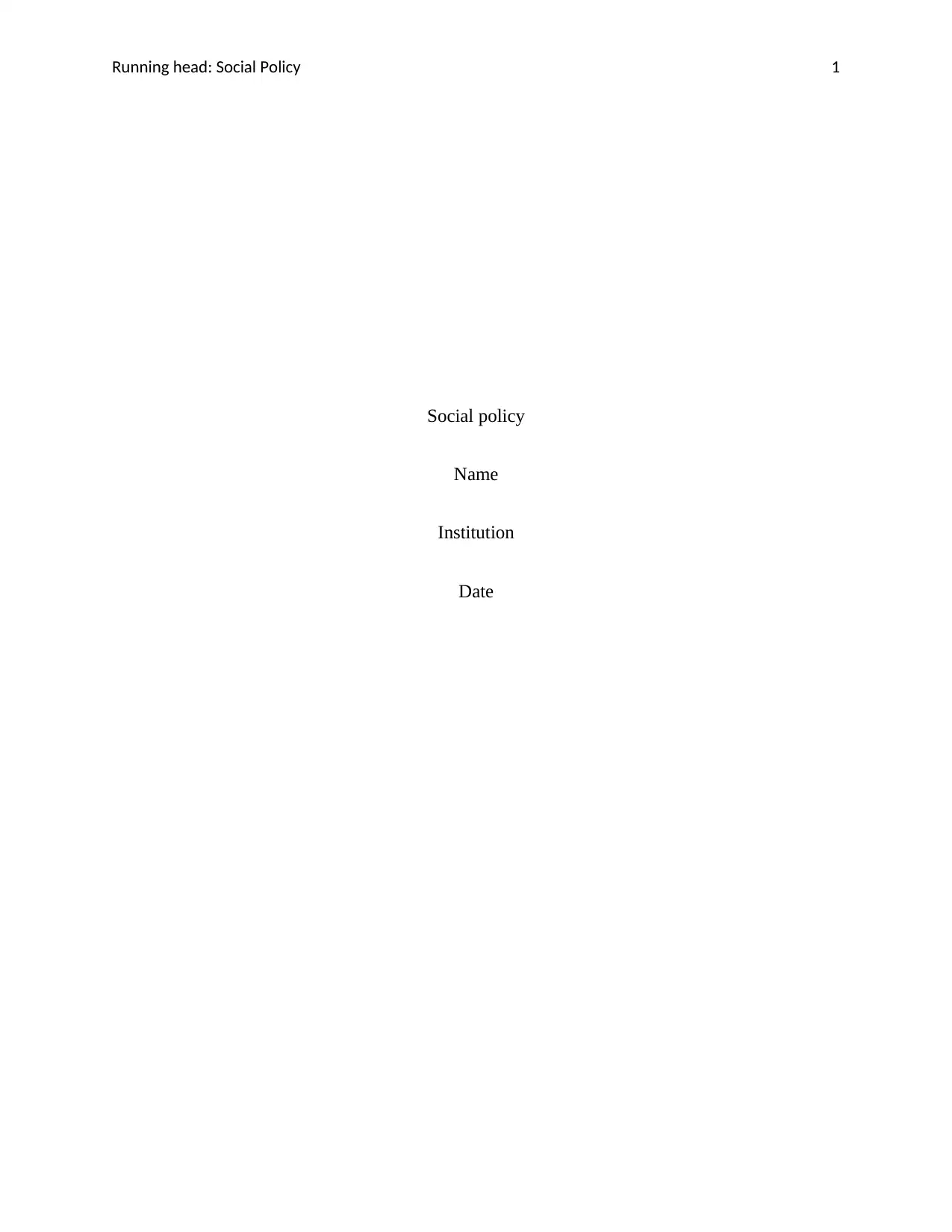
Running head: Social Policy 1
Social policy
Name
Institution
Date
Social policy
Name
Institution
Date
Paraphrase This Document
Need a fresh take? Get an instant paraphrase of this document with our AI Paraphraser
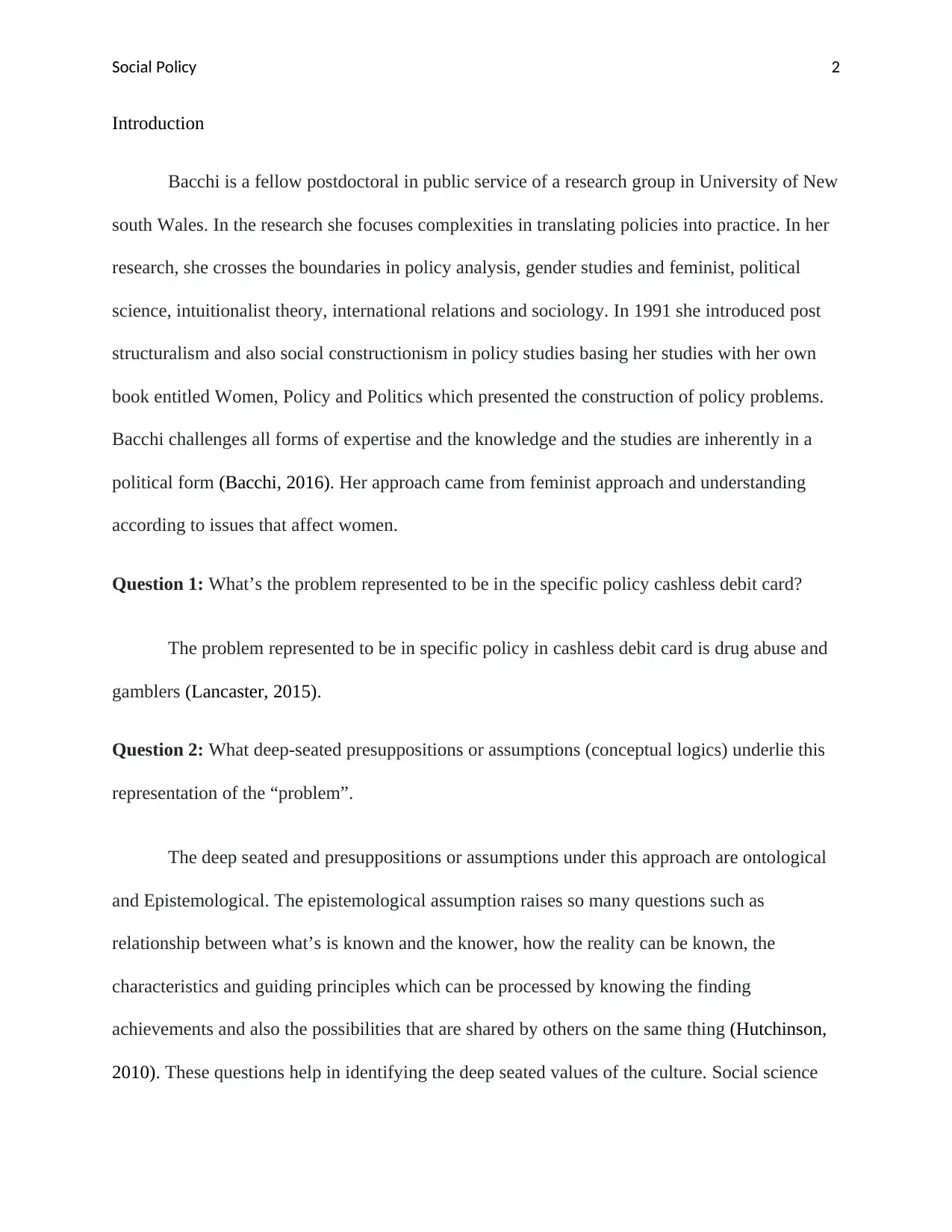
Social Policy 2
Introduction
Bacchi is a fellow postdoctoral in public service of a research group in University of New
south Wales. In the research she focuses complexities in translating policies into practice. In her
research, she crosses the boundaries in policy analysis, gender studies and feminist, political
science, intuitionalist theory, international relations and sociology. In 1991 she introduced post
structuralism and also social constructionism in policy studies basing her studies with her own
book entitled Women, Policy and Politics which presented the construction of policy problems.
Bacchi challenges all forms of expertise and the knowledge and the studies are inherently in a
political form (Bacchi, 2016). Her approach came from feminist approach and understanding
according to issues that affect women.
Question 1: What’s the problem represented to be in the specific policy cashless debit card?
The problem represented to be in specific policy in cashless debit card is drug abuse and
gamblers (Lancaster, 2015).
Question 2: What deep-seated presuppositions or assumptions (conceptual logics) underlie this
representation of the “problem”.
The deep seated and presuppositions or assumptions under this approach are ontological
and Epistemological. The epistemological assumption raises so many questions such as
relationship between what’s is known and the knower, how the reality can be known, the
characteristics and guiding principles which can be processed by knowing the finding
achievements and also the possibilities that are shared by others on the same thing (Hutchinson,
2010). These questions help in identifying the deep seated values of the culture. Social science
Introduction
Bacchi is a fellow postdoctoral in public service of a research group in University of New
south Wales. In the research she focuses complexities in translating policies into practice. In her
research, she crosses the boundaries in policy analysis, gender studies and feminist, political
science, intuitionalist theory, international relations and sociology. In 1991 she introduced post
structuralism and also social constructionism in policy studies basing her studies with her own
book entitled Women, Policy and Politics which presented the construction of policy problems.
Bacchi challenges all forms of expertise and the knowledge and the studies are inherently in a
political form (Bacchi, 2016). Her approach came from feminist approach and understanding
according to issues that affect women.
Question 1: What’s the problem represented to be in the specific policy cashless debit card?
The problem represented to be in specific policy in cashless debit card is drug abuse and
gamblers (Lancaster, 2015).
Question 2: What deep-seated presuppositions or assumptions (conceptual logics) underlie this
representation of the “problem”.
The deep seated and presuppositions or assumptions under this approach are ontological
and Epistemological. The epistemological assumption raises so many questions such as
relationship between what’s is known and the knower, how the reality can be known, the
characteristics and guiding principles which can be processed by knowing the finding
achievements and also the possibilities that are shared by others on the same thing (Hutchinson,
2010). These questions help in identifying the deep seated values of the culture. Social science
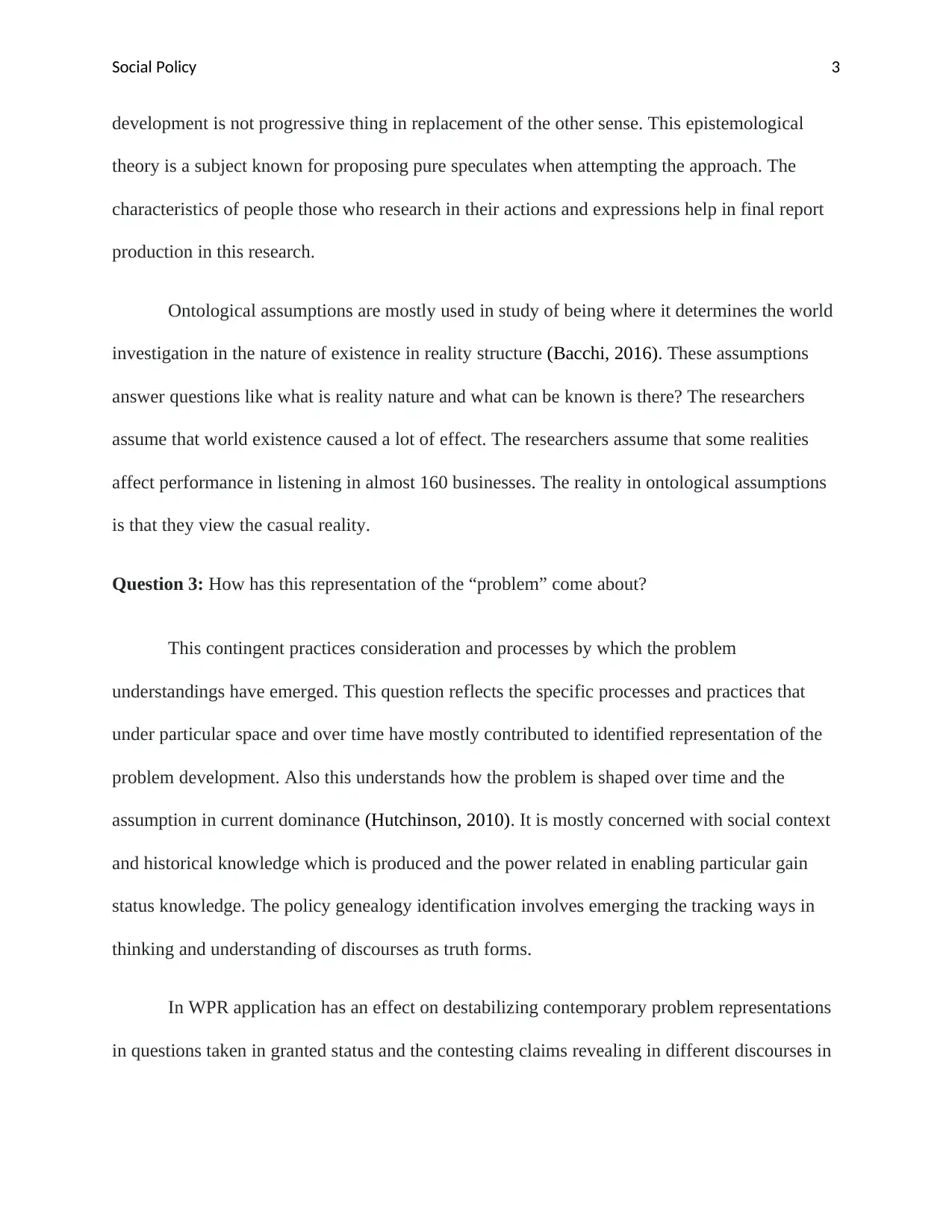
Social Policy 3
development is not progressive thing in replacement of the other sense. This epistemological
theory is a subject known for proposing pure speculates when attempting the approach. The
characteristics of people those who research in their actions and expressions help in final report
production in this research.
Ontological assumptions are mostly used in study of being where it determines the world
investigation in the nature of existence in reality structure (Bacchi, 2016). These assumptions
answer questions like what is reality nature and what can be known is there? The researchers
assume that world existence caused a lot of effect. The researchers assume that some realities
affect performance in listening in almost 160 businesses. The reality in ontological assumptions
is that they view the casual reality.
Question 3: How has this representation of the “problem” come about?
This contingent practices consideration and processes by which the problem
understandings have emerged. This question reflects the specific processes and practices that
under particular space and over time have mostly contributed to identified representation of the
problem development. Also this understands how the problem is shaped over time and the
assumption in current dominance (Hutchinson, 2010). It is mostly concerned with social context
and historical knowledge which is produced and the power related in enabling particular gain
status knowledge. The policy genealogy identification involves emerging the tracking ways in
thinking and understanding of discourses as truth forms.
In WPR application has an effect on destabilizing contemporary problem representations
in questions taken in granted status and the contesting claims revealing in different discourses in
development is not progressive thing in replacement of the other sense. This epistemological
theory is a subject known for proposing pure speculates when attempting the approach. The
characteristics of people those who research in their actions and expressions help in final report
production in this research.
Ontological assumptions are mostly used in study of being where it determines the world
investigation in the nature of existence in reality structure (Bacchi, 2016). These assumptions
answer questions like what is reality nature and what can be known is there? The researchers
assume that world existence caused a lot of effect. The researchers assume that some realities
affect performance in listening in almost 160 businesses. The reality in ontological assumptions
is that they view the casual reality.
Question 3: How has this representation of the “problem” come about?
This contingent practices consideration and processes by which the problem
understandings have emerged. This question reflects the specific processes and practices that
under particular space and over time have mostly contributed to identified representation of the
problem development. Also this understands how the problem is shaped over time and the
assumption in current dominance (Hutchinson, 2010). It is mostly concerned with social context
and historical knowledge which is produced and the power related in enabling particular gain
status knowledge. The policy genealogy identification involves emerging the tracking ways in
thinking and understanding of discourses as truth forms.
In WPR application has an effect on destabilizing contemporary problem representations
in questions taken in granted status and the contesting claims revealing in different discourses in
⊘ This is a preview!⊘
Do you want full access?
Subscribe today to unlock all pages.

Trusted by 1+ million students worldwide
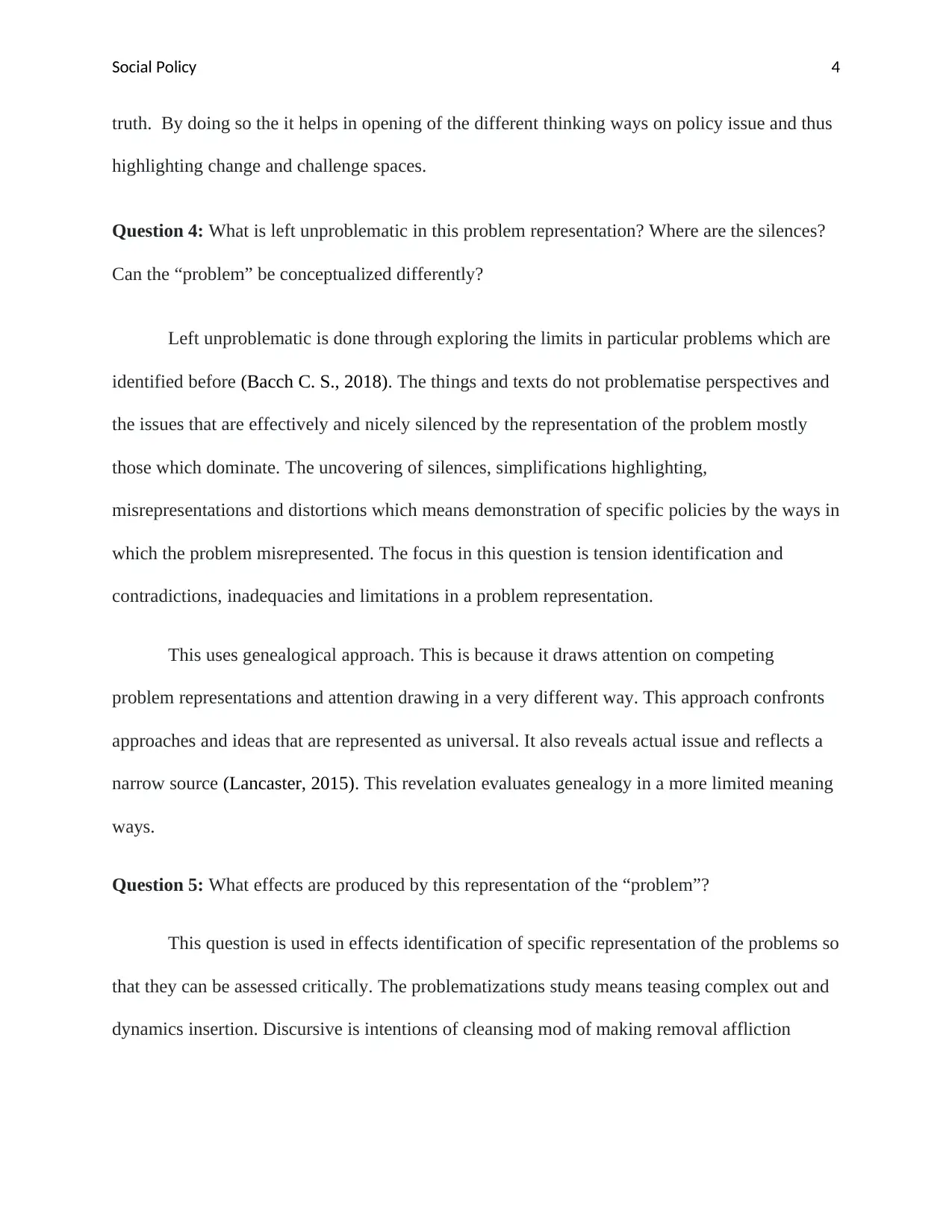
Social Policy 4
truth. By doing so the it helps in opening of the different thinking ways on policy issue and thus
highlighting change and challenge spaces.
Question 4: What is left unproblematic in this problem representation? Where are the silences?
Can the “problem” be conceptualized differently?
Left unproblematic is done through exploring the limits in particular problems which are
identified before (Bacch C. S., 2018). The things and texts do not problematise perspectives and
the issues that are effectively and nicely silenced by the representation of the problem mostly
those which dominate. The uncovering of silences, simplifications highlighting,
misrepresentations and distortions which means demonstration of specific policies by the ways in
which the problem misrepresented. The focus in this question is tension identification and
contradictions, inadequacies and limitations in a problem representation.
This uses genealogical approach. This is because it draws attention on competing
problem representations and attention drawing in a very different way. This approach confronts
approaches and ideas that are represented as universal. It also reveals actual issue and reflects a
narrow source (Lancaster, 2015). This revelation evaluates genealogy in a more limited meaning
ways.
Question 5: What effects are produced by this representation of the “problem”?
This question is used in effects identification of specific representation of the problems so
that they can be assessed critically. The problematizations study means teasing complex out and
dynamics insertion. Discursive is intentions of cleansing mod of making removal affliction
truth. By doing so the it helps in opening of the different thinking ways on policy issue and thus
highlighting change and challenge spaces.
Question 4: What is left unproblematic in this problem representation? Where are the silences?
Can the “problem” be conceptualized differently?
Left unproblematic is done through exploring the limits in particular problems which are
identified before (Bacch C. S., 2018). The things and texts do not problematise perspectives and
the issues that are effectively and nicely silenced by the representation of the problem mostly
those which dominate. The uncovering of silences, simplifications highlighting,
misrepresentations and distortions which means demonstration of specific policies by the ways in
which the problem misrepresented. The focus in this question is tension identification and
contradictions, inadequacies and limitations in a problem representation.
This uses genealogical approach. This is because it draws attention on competing
problem representations and attention drawing in a very different way. This approach confronts
approaches and ideas that are represented as universal. It also reveals actual issue and reflects a
narrow source (Lancaster, 2015). This revelation evaluates genealogy in a more limited meaning
ways.
Question 5: What effects are produced by this representation of the “problem”?
This question is used in effects identification of specific representation of the problems so
that they can be assessed critically. The problematizations study means teasing complex out and
dynamics insertion. Discursive is intentions of cleansing mod of making removal affliction
Paraphrase This Document
Need a fresh take? Get an instant paraphrase of this document with our AI Paraphraser
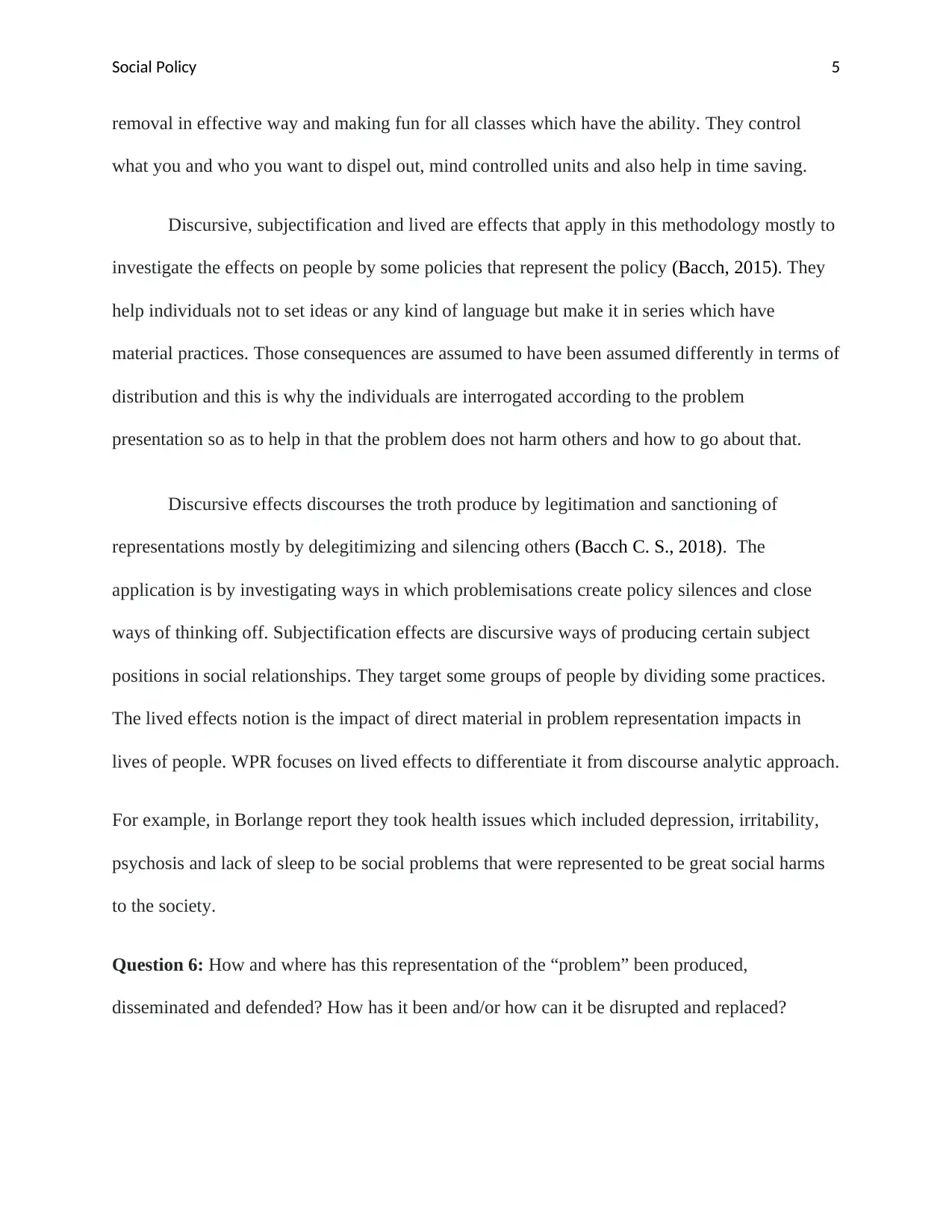
Social Policy 5
removal in effective way and making fun for all classes which have the ability. They control
what you and who you want to dispel out, mind controlled units and also help in time saving.
Discursive, subjectification and lived are effects that apply in this methodology mostly to
investigate the effects on people by some policies that represent the policy (Bacch, 2015). They
help individuals not to set ideas or any kind of language but make it in series which have
material practices. Those consequences are assumed to have been assumed differently in terms of
distribution and this is why the individuals are interrogated according to the problem
presentation so as to help in that the problem does not harm others and how to go about that.
Discursive effects discourses the troth produce by legitimation and sanctioning of
representations mostly by delegitimizing and silencing others (Bacch C. S., 2018). The
application is by investigating ways in which problemisations create policy silences and close
ways of thinking off. Subjectification effects are discursive ways of producing certain subject
positions in social relationships. They target some groups of people by dividing some practices.
The lived effects notion is the impact of direct material in problem representation impacts in
lives of people. WPR focuses on lived effects to differentiate it from discourse analytic approach.
For example, in Borlange report they took health issues which included depression, irritability,
psychosis and lack of sleep to be social problems that were represented to be great social harms
to the society.
Question 6: How and where has this representation of the “problem” been produced,
disseminated and defended? How has it been and/or how can it be disrupted and replaced?
removal in effective way and making fun for all classes which have the ability. They control
what you and who you want to dispel out, mind controlled units and also help in time saving.
Discursive, subjectification and lived are effects that apply in this methodology mostly to
investigate the effects on people by some policies that represent the policy (Bacch, 2015). They
help individuals not to set ideas or any kind of language but make it in series which have
material practices. Those consequences are assumed to have been assumed differently in terms of
distribution and this is why the individuals are interrogated according to the problem
presentation so as to help in that the problem does not harm others and how to go about that.
Discursive effects discourses the troth produce by legitimation and sanctioning of
representations mostly by delegitimizing and silencing others (Bacch C. S., 2018). The
application is by investigating ways in which problemisations create policy silences and close
ways of thinking off. Subjectification effects are discursive ways of producing certain subject
positions in social relationships. They target some groups of people by dividing some practices.
The lived effects notion is the impact of direct material in problem representation impacts in
lives of people. WPR focuses on lived effects to differentiate it from discourse analytic approach.
For example, in Borlange report they took health issues which included depression, irritability,
psychosis and lack of sleep to be social problems that were represented to be great social harms
to the society.
Question 6: How and where has this representation of the “problem” been produced,
disseminated and defended? How has it been and/or how can it be disrupted and replaced?
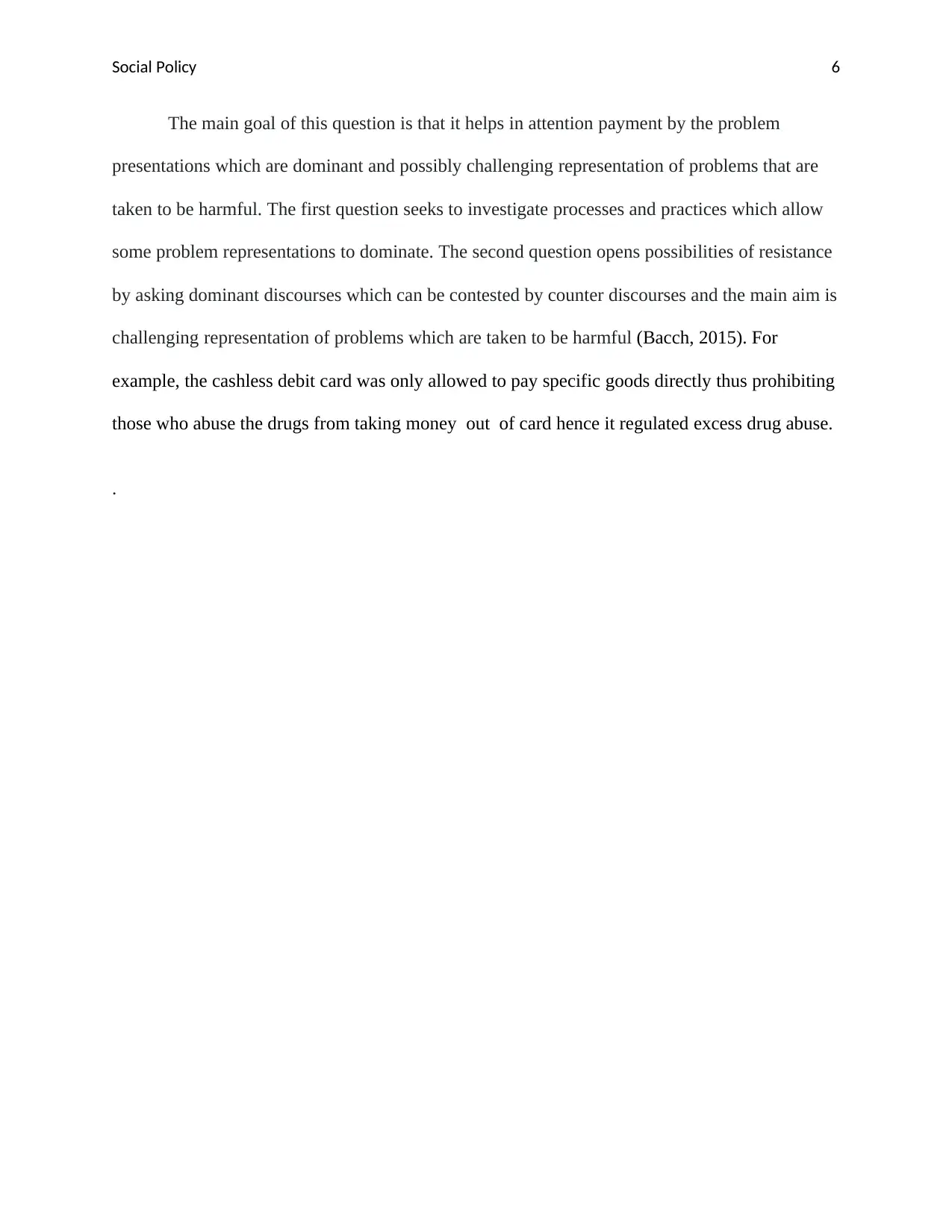
Social Policy 6
The main goal of this question is that it helps in attention payment by the problem
presentations which are dominant and possibly challenging representation of problems that are
taken to be harmful. The first question seeks to investigate processes and practices which allow
some problem representations to dominate. The second question opens possibilities of resistance
by asking dominant discourses which can be contested by counter discourses and the main aim is
challenging representation of problems which are taken to be harmful (Bacch, 2015). For
example, the cashless debit card was only allowed to pay specific goods directly thus prohibiting
those who abuse the drugs from taking money out of card hence it regulated excess drug abuse.
.
The main goal of this question is that it helps in attention payment by the problem
presentations which are dominant and possibly challenging representation of problems that are
taken to be harmful. The first question seeks to investigate processes and practices which allow
some problem representations to dominate. The second question opens possibilities of resistance
by asking dominant discourses which can be contested by counter discourses and the main aim is
challenging representation of problems which are taken to be harmful (Bacch, 2015). For
example, the cashless debit card was only allowed to pay specific goods directly thus prohibiting
those who abuse the drugs from taking money out of card hence it regulated excess drug abuse.
.
⊘ This is a preview!⊘
Do you want full access?
Subscribe today to unlock all pages.

Trusted by 1+ million students worldwide
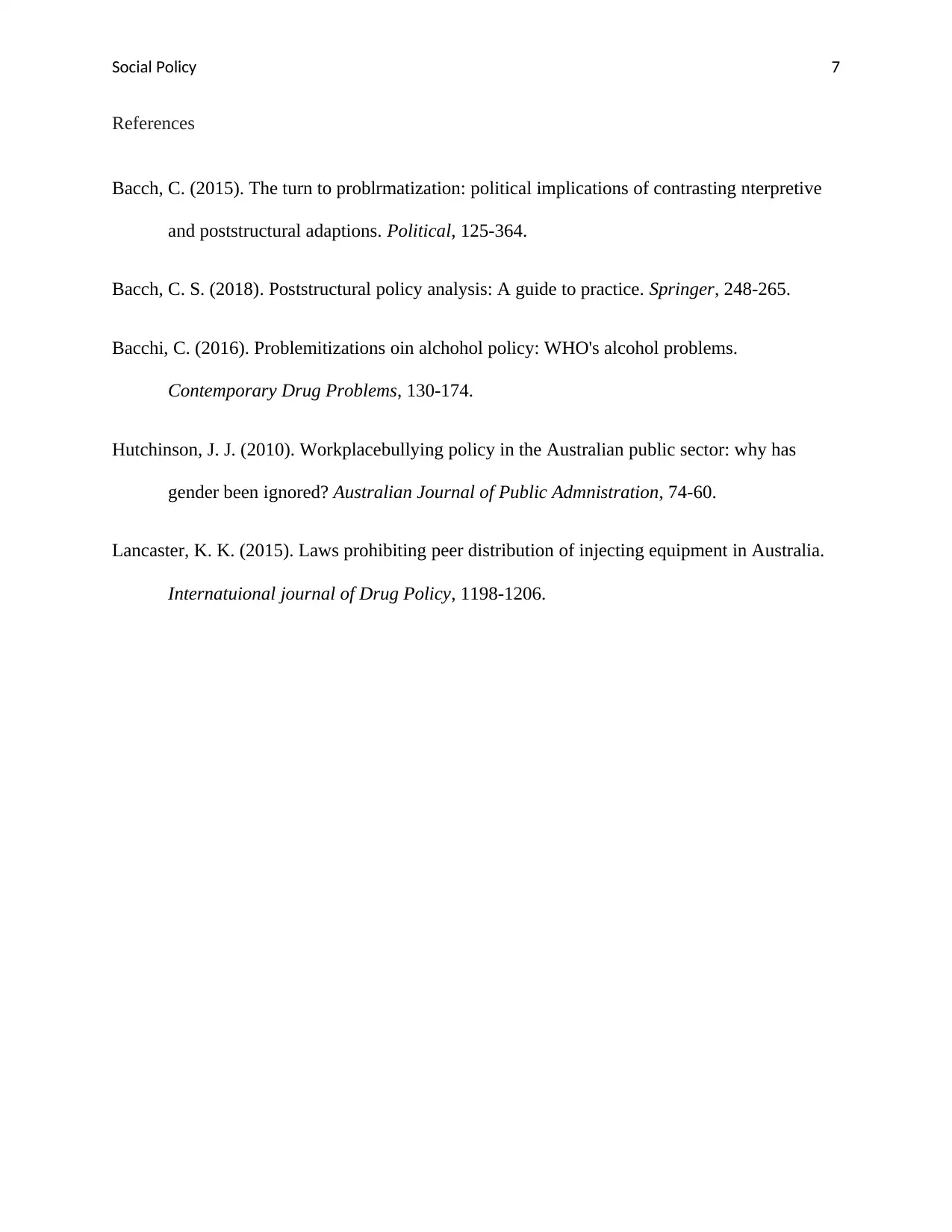
Social Policy 7
References
Bacch, C. (2015). The turn to problrmatization: political implications of contrasting nterpretive
and poststructural adaptions. Political, 125-364.
Bacch, C. S. (2018). Poststructural policy analysis: A guide to practice. Springer, 248-265.
Bacchi, C. (2016). Problemitizations oin alchohol policy: WHO's alcohol problems.
Contemporary Drug Problems, 130-174.
Hutchinson, J. J. (2010). Workplacebullying policy in the Australian public sector: why has
gender been ignored? Australian Journal of Public Admnistration, 74-60.
Lancaster, K. K. (2015). Laws prohibiting peer distribution of injecting equipment in Australia.
Internatuional journal of Drug Policy, 1198-1206.
References
Bacch, C. (2015). The turn to problrmatization: political implications of contrasting nterpretive
and poststructural adaptions. Political, 125-364.
Bacch, C. S. (2018). Poststructural policy analysis: A guide to practice. Springer, 248-265.
Bacchi, C. (2016). Problemitizations oin alchohol policy: WHO's alcohol problems.
Contemporary Drug Problems, 130-174.
Hutchinson, J. J. (2010). Workplacebullying policy in the Australian public sector: why has
gender been ignored? Australian Journal of Public Admnistration, 74-60.
Lancaster, K. K. (2015). Laws prohibiting peer distribution of injecting equipment in Australia.
Internatuional journal of Drug Policy, 1198-1206.
1 out of 7
Your All-in-One AI-Powered Toolkit for Academic Success.
+13062052269
info@desklib.com
Available 24*7 on WhatsApp / Email
![[object Object]](/_next/static/media/star-bottom.7253800d.svg)
Unlock your academic potential
Copyright © 2020–2025 A2Z Services. All Rights Reserved. Developed and managed by ZUCOL.

